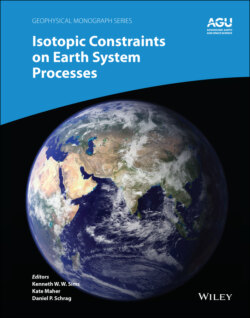Читать книгу Isotopic Constraints on Earth System Processes - Группа авторов - Страница 47
2.1. INTRODUCTION
ОглавлениеIgneous and metamorphic rocks exhibit stable isotope variations in excess of what can reasonably be attributed to mixing processes or equilibrium partitioning during partial melting and (re)crystallization. Experimental studies have shown that diffusion is capable of generating measurable (sub‐permil) to large (tens of permil) kinetic isotopic fractionations that can account for some of this variability, and detailed knowledge of these effects can yield unique insights into the molecular level controls on diffusive transport and the role of kinetics in the formation of minerals in high temperature settings (Antonelli et al., 2019b; Barrat et al., 2005; Beck et al., 2006; Chen et al., 2018; Chopra et al., 2012; Dauphas, 2007; Dauphas et al., 2010; Gallagher & Elliott, 2009; Gao et al., 2011; Jeffcoate et al., 2007; Kil et al., 2016; Lundstrom et al., 2005; Marschall et al., 2007; Mueller et al., 2014; Oeser et al., 2015; Parkinson et al., 2007; Richter et al., 2009, 2014, 2016, 2017; Roskosz et al., 2006; Rudnick & Ionov, 2007; Sio et al., 2013; Su et al., 2016; Teng et al., 2006, 2011; Wu et al., 2018; Zhao et al., 2017).
Current knowledge of diffusive isotopic fractionations in molten silicates is based on a few elements (Ca, Fe, Mg, Li, and Si) and silicate melt compositions (cf. Watkins et al., 2017, for a review). The mass dependence on diffusion coefficients varies between cations and with liquid composition. In basalt‐rhyolite diffusion couples, for example, the stable isotopes of major elements (Ca, Fe, Mg) exhibit less mass discrimination ( β < 0.075) than the stable isotopes of trace element Li ( β ≈ 0.215) (Richter et al., 2003, 2009; Watkins et al., 2009). In simplified silicate liquids, it has been found that the β factor for Ca and Mg varies between 0.05 and 0.21, depending on liquid composition, and is correlated with the “solvent‐normalized” diffusivity (e.g., DCa/DSi), suggesting that faster diffusing elements exhibit greater mass discrimination because they move as single atoms or small moities whose diffusion is decoupled from that of the major melt structures/components (Goel et al., 2012; Watkins et al., 2009, 2011). This simple relationship provides a useful framework for choosing an appropriate value for β in diffusion models and for predicting where there might be large diffusive isotope effects in nature.
In this contribution, we present results from new diffusion couple experiments with two motivating factors in mind. First, the solvent‐normalized diffusivity can only be defined in situations where there is a large initial concentration gradient for the component of interest and an effective binary diffusion model is applicable. And yet, we are aware that large diffusive isotope effects can arise even in the absence of large initial concentration gradients. One such example is in ugandite‐rhyolite diffusion couple experiments where Ca isotopes were fractionated by ∼2‰ due to diffusive coupling of CaO with Al2O3 (Watkins et al., 2009). Such strong multicomponent diffusion effects warrant further investigation because they may contribute to isotope variations within and among minerals formed in high‐T settings. Second, the ratio Di/DSi tends to be lower and approach unity for elements that are present in major quantities because the net flux of a major element requires cooperative motion of the other major components of the liquid. The β factor for Li can be high because it diffuses fast, and it can diffuse fast because it is present in trace quantities. The same may be true for Ca; the β factor for Ca approaches that of Li in experiments where Ca is present in minor quantities (∼2 wt%; Watkins et al., 2011). These observations raise the question of whether the (typically) fast‐diffusing K2O component will behave like Li and have a high β factor or whether it will behave like other major elements and have a β factor closer to zero.
